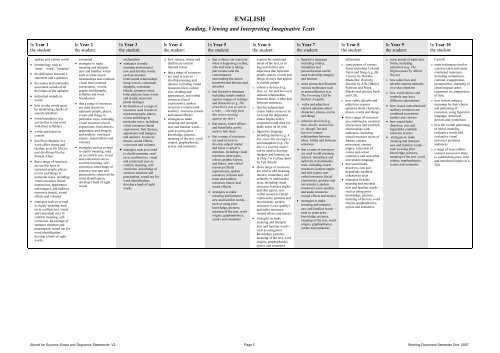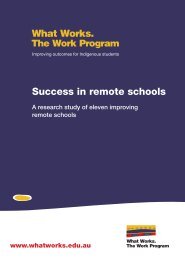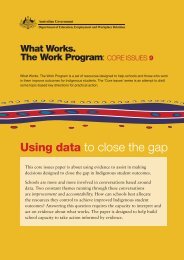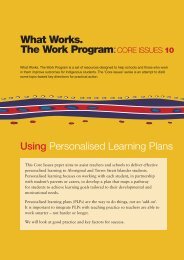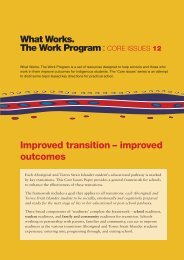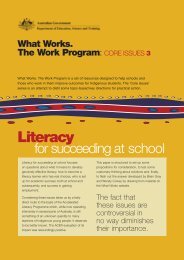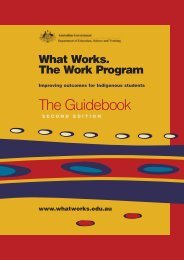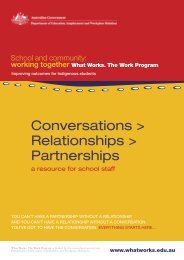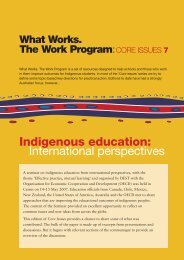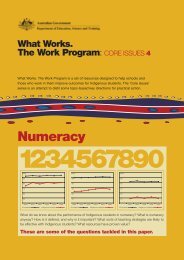ENGLISHReading, Viewing <strong>and</strong> Interpreting Imaginative TextsIn Year 1the student:In Year 2the student:In Year 3the student:In Year 4the student:In Year 5the student:In Year 6the student:In Year 7the student:In Year 8the student:In Year 9the student:In Year 10the student:spoken <strong>and</strong> written words• terminology such as‘letter’, ‘word’, ‘sentence’• the difference between astatement <strong>and</strong> a question• the names <strong>and</strong> commonlyassociated sounds of allthe letters of the alphabet• individual sounds inwords• how to take words apartby identifying chunks ofsound (syllables)• word boundaries (e.g.yes/ter/day is one wordwith three syllables)• words <strong>and</strong> letters incontext• that final elements in aword affect rhyme <strong>and</strong>rhythm, as in Mr McGee<strong>and</strong> the Biting Flea byPamela Allen• that a range of resourcesare used in texts torepresent people, places,events <strong>and</strong> things inparticular ways, includingvisual resources (facialexpressions, appearance<strong>and</strong> images), <strong>and</strong> auditoryresources (music, soundeffects <strong>and</strong> volume)• strategies such as re-readto clarify meaning, readon to confirm text, visual<strong>and</strong> contextual cues toconfirm meaning, selfcorrection,knowledge ofsentence structure <strong>and</strong>punctuation, sound out <strong>for</strong>word identification,develop a bank of sightwords.comm<strong>and</strong>• strategies to makemeaning <strong>and</strong> interpretnew <strong>and</strong> familiar wordssuch as letter/soundrelationships <strong>and</strong> commonvisual letter patterns(consonants, vowels,graphs <strong>and</strong> digraphs,syllables <strong>and</strong> wordboundaries)• that a range of resourcesare used in texts torepresent people, places,events <strong>and</strong> things inparticular ways, includingvisual resources (facialexpressions, font choices,appearance <strong>and</strong> images),<strong>and</strong> auditory resources(music, sound effects <strong>and</strong>volume)• strategies such as re-readto clarify meaning, readon to confirm text, visual<strong>and</strong> contextual cues toconfirm meaning, selfcorrection,knowledge ofsentence structure <strong>and</strong>punctuation, sound out <strong>for</strong>word identification,develop a bank of sightwordsexclamation• strategies to makemeaning <strong>and</strong> interpretnew <strong>and</strong> familiar wordssuch as commonletter/sound relationships(long vowels, consonantdigraphs, consonantblends, common visualletter patterns, base words<strong>and</strong> simple tense <strong>and</strong>plural endings)• the function of a range ofresources used in texts torepresent people, places,events <strong>and</strong> things inparticular ways, includingvisual resources (facialexpressions, font choices,appearance <strong>and</strong> images),<strong>and</strong> auditory resources(music, sound effects,voice tone <strong>and</strong> volume)• strategies such as re-readto clarify meaning, readon to confirm text, visual<strong>and</strong> contextual cues toconfirm meaning, selfcorrection,knowledge ofsentence structure <strong>and</strong>punctuation, sound out <strong>for</strong>word identification,develop a bank of sightwordso how stanzas, rhyme <strong>and</strong>rhythm are used inrhymed verses• that a range of resourcesare used in texts todevelop meaning <strong>and</strong>interest, including visualresources (font, colour,size, clothing <strong>and</strong>appearance), non-verbalresources (facialexpressions), spokenresources (volume) <strong>and</strong>auditory resources (music<strong>and</strong> sound effects)• strategies to makemeaning <strong>and</strong> interpretnew <strong>and</strong> familiar words −such as using priorknowledge, pictures,meaning of the text, wordorigins, graphophonics,syntax <strong>and</strong> semanticso that a clause can representwhat is happening (verbs),who <strong>and</strong> what is takingpart (nouns) <strong>and</strong> thecircumstancessurrounding the action(prepositional phrases <strong>and</strong>adverbs)o that figurative languageincluding simple similesexpress images of settings<strong>and</strong> characters (e.g. Thestrawberry was as red asa ruby. …the kelp feelslike velvet swirlingagainst my skin.)o that music, sound effects<strong>and</strong> hyperlinks can beused to link ideaso that a range of resourcesare used in texts todevelop subject matter<strong>and</strong> focus a viewer’sattention, including visualresources (shot types,colour, graphic layout,<strong>and</strong> links), non-verbalresources (facialexpressions), spokenresources (volume <strong>and</strong>tone) <strong>and</strong> auditoryresources (music <strong>and</strong>sound effects)• strategies to makemeaning <strong>and</strong> interpretnew <strong>and</strong> familiar words −such as using priorknowledge, pictures,meaning of the text, wordorigins, graphophonics,syntax <strong>and</strong> semanticsexpress the emotionalintent of the text, as inhug <strong>and</strong> dislike) <strong>and</strong>adjectives that representpeople, places, events <strong>and</strong>things in ways that appealto certain groupso cohesive devices (e.g.then, so, but <strong>and</strong> however)indicate relationshipsbetween ideas, within <strong>and</strong>between sentenceso that the independentclause makes sense on itsown <strong>and</strong> the dependentclause begins with aconjunction <strong>and</strong> does notmake sense on its owno figurative languageincluding similes (e.g. Akite soars like an eagle.)<strong>and</strong> metaphors (e.g. Thekite is a soaring eagle.)can be used to developimagery <strong>and</strong> humour, asin Help I’m Falling Apartby Ted Arnold• that a range of resourcesare used to add meaning,interest, immediacy <strong>and</strong>authority to multimodaltexts, including visualresources (camera angles<strong>and</strong> shot types), nonverbalresources (facialexpressions, gestures <strong>and</strong>movements), spokenresources (voice quality)<strong>and</strong> audio resources(sound effects <strong>and</strong> music)• strategies to makemeaning <strong>and</strong> interpretnew <strong>and</strong> familiar words −such as using priorknowledge, pictures,meaning of the text, wordorigins, graphophonics,syntax <strong>and</strong> semanticso figurative languageincluding similes,metaphors <strong>and</strong>personification can beused to develop imagery<strong>and</strong> humouro some poems that illustratevarious techniques suchas personification (e.g.The Frowning Cliff byHerbert Asquith)o verbs <strong>and</strong> adjectivesexpress opinions aboutcharacters, places, events<strong>and</strong> thingso cohesive devices (e.g.then, finally, meanwhile,so, though, but <strong>and</strong>however) signalrelationships betweenideas, within <strong>and</strong> betweensentences• that a range of resourcesare used to add meaning,interest, immediacy <strong>and</strong>authority to multimediatexts, including visualresources (camera angles<strong>and</strong> shot types), nonverbalresources (facialexpressions, gestures <strong>and</strong>movements), spokenresources (voice quality)<strong>and</strong> audio resources(sound effects <strong>and</strong> music)• strategies to makemeaning <strong>and</strong> interpretnew <strong>and</strong> familiar words −such as using priorknowledge, pictures,meaning of the text, wordorigins, graphophonics,syntax <strong>and</strong> semanticsalliterationo some poems of various<strong>for</strong>ms including ColonialVerse <strong>and</strong> Song (e.g. MyCountry by DorothyMackellar; WaltzingMatilda by A.B. (Banjo)Paterson <strong>and</strong> FreyaBlackwood (picture book<strong>and</strong> CD);o how verbs, adverbs <strong>and</strong>adjectives expressopinions about characters,places, events <strong>and</strong> things• that a range of resourcesare combined to constructinteractions <strong>and</strong> establishrelationships withaudiences, includingvisual resources (sizes offrames, cameramovement, cameraangles, saturation ofcolour <strong>and</strong> colourcontrasts), <strong>and</strong> nonverbal<strong>and</strong> spoken language• that sound fades,dissolves, cuts <strong>and</strong>hyperlinks establishcohesion in texts• strategies to makemeaning <strong>and</strong> interpretnew <strong>and</strong> familiar words −such as using priorknowledge, pictures,meaning of the text, wordorigins, graphophonics,syntax <strong>and</strong> semanticso some poems of particular<strong>for</strong>ms, includingnarratives (e.g. TheHighwayman by AlfredNoyes)o how adjectives <strong>and</strong>adverbs express attitudesor evoke emotionso how word choices <strong>and</strong>symbols may havedifferent connotations• how visual, nonverbal <strong>and</strong>auditory resources arecombined to positionreaders <strong>and</strong> viewers• how sound fades,dissolves, cuts <strong>and</strong>hyperlinks establishcohesion in texts• strategies to makemeaning <strong>and</strong> interpretnew <strong>and</strong> familiar words −such as using priorknowledge, pictures,meaning of the text, wordorigins, graphophonics,syntax <strong>and</strong> semanticsCarroll)o some techniques used toconstruct plot <strong>and</strong> createemotional responses,including comparison,contrast, exaggeration,juxtaposition, changing ofchronological order,expansion or compressionof timeo how writers enhancemeanings by their choice<strong>and</strong> patterning ofresources, using figurativelanguage, rhetoricaldevices <strong>and</strong> symbolismo how the overall patterningof mood, modality,evaluative words <strong>and</strong>evaluative visualresources positionsaudienceso a range of ways editorsconnect successive shotsto establish the pace, tone<strong>and</strong> emotional impact of afilm<strong>Bound</strong> <strong>for</strong> <strong>Success</strong> <strong>Scope</strong> <strong>and</strong> <strong>Sequence</strong> <strong>Statements</strong> V2 Page 5 Working Document Semester One 2007
ENGLISHReading, Viewing <strong>and</strong> Interpreting Simple In<strong>for</strong>mation <strong>and</strong> Argument TextsIn Years 1, 2 <strong>and</strong> 3 students use simple in<strong>for</strong>mation <strong>and</strong> argument texts related to their own experiences. These texts canentertain, report, explain <strong>and</strong> give opinions.In Years 4, 5 & 6 students use in<strong>for</strong>mation <strong>and</strong> argument texts containing in<strong>for</strong>mation <strong>and</strong> ideas extending beyond theirimmediate experience. These texts can entertain, report, present opinions <strong>and</strong> persuade.In Years 7 & 8 students use in<strong>for</strong>mation <strong>and</strong> argument texts containing in<strong>for</strong>mation <strong>and</strong> ideas relating to significant events<strong>and</strong> issues that may be of interest to the students. These texts can entertain, evaluate, argue <strong>and</strong> persuade.In Years 9 & 10 students use in<strong>for</strong>mation <strong>and</strong> argument texts containing accessible but challenging issues that deal withlocal, national <strong>and</strong> international events <strong>and</strong> current issues that develop over time. These texts may include current affairs <strong>and</strong>news articles, features, editorials, documentaries <strong>and</strong> reviews.In Year 1the student:In Year 2the student:In Year 3the student:In Year 4the student:In Year 5the student:In Year 6the student:In Year 7the student:In Year 8the student:In Year 9the student:In Year 10the student:underst<strong>and</strong>s that:o in<strong>for</strong>mation texts report<strong>and</strong> explain in<strong>for</strong>mation<strong>and</strong> events of personalsignificance (e.g.birthdays, families)underst<strong>and</strong>s that:o in<strong>for</strong>mation texts canreport <strong>and</strong> explainin<strong>for</strong>mation <strong>and</strong> events ofpersonal interest (e.g.sport, music)o in<strong>for</strong>mation texts areproduced <strong>for</strong> differentaudienceso main ideas are maintainedthroughout related pagesor sections of textunderst<strong>and</strong>s that:o in<strong>for</strong>mation texts canreport <strong>and</strong> explainin<strong>for</strong>mation <strong>and</strong> events,report recent newsworthyevents, <strong>and</strong> give opinionso in<strong>for</strong>mation texts can beproduced <strong>for</strong> differentaudienceso the interests of theintended readers <strong>and</strong>viewers can be reflectedin the textunderst<strong>and</strong>s that:o the main ideas inin<strong>for</strong>mation <strong>and</strong> argumenttexts are developed byelaborating on ideas <strong>and</strong>in<strong>for</strong>mation withsupporting detailunderst<strong>and</strong>s that:o texts usually have a pointof viewo aspects of subject mattercan be included oromitted to create aparticular perspective orto heightennewsworthinessunderst<strong>and</strong>s that:o texts present a point ofview that is supported bya series of facts, opinions<strong>and</strong> ideas as in theAustralians All series byAl Grassby <strong>and</strong> Marji Hillo argument texts use a<strong>for</strong>mal, logical structureto argue a case, whichincludes a point of view<strong>and</strong> an elaboration of itwith explanation, moredetails, evidence <strong>and</strong>exampleso creators of texts selectideas <strong>and</strong> in<strong>for</strong>mation tosupport their position orpurpose, <strong>and</strong> appeal to orsuit different audiencesunderst<strong>and</strong>s that:o texts can be constructed<strong>for</strong> more than onepurpose, including toreport, to present a pointof view, <strong>and</strong> to create amarket <strong>for</strong> more readers<strong>and</strong> viewerso argument texts require aposition supported by aline of reasoningo creators of texts use theirassumptions about readers<strong>and</strong> viewers to engagetheir interest <strong>and</strong> attentiono aspects of subject matterare selected to appeal to,<strong>and</strong> to influence, differentgroups of readers <strong>and</strong>viewersunderst<strong>and</strong>s that:o in<strong>for</strong>mation <strong>and</strong> argumenttexts can be constructed<strong>for</strong> multiple purposesincluding to in<strong>for</strong>m, toadvance opinions, tojustify positions, to makejudgements <strong>and</strong> topersuade otherso arguments use a <strong>for</strong>mal,logical structure to arguea case with a positionsupported by a line ofreasoningo subject matter is selected<strong>for</strong> particular texts totarget people with specialinterests <strong>and</strong> needs (e.g.news programming ondifferent channels is usedto appeal to differentaudiences)o creators of texts selectlanguage to constructpositive <strong>and</strong> negativerepresentations of people,places, events <strong>and</strong> thingsunderst<strong>and</strong>s that:o in<strong>for</strong>mation <strong>and</strong>argument texts cananalyse, evaluate <strong>and</strong> usehumourooooargument texts canadvance opinions, justifypositions, <strong>and</strong> makejudgements in order topersuade othersreaders <strong>and</strong> viewers mayneed to developknowledge aboutparticular events, issues<strong>and</strong> contexts to interpretthe subject matter oftextscreators of texts selectlanguage to representideas, in<strong>for</strong>mation <strong>and</strong>concepts in particularwaysreaders’ <strong>and</strong> viewers’interpretations of textsare influenced by theirown knowledge, values<strong>and</strong> practicesunderst<strong>and</strong>s that:o in<strong>for</strong>mation <strong>and</strong>argument texts canentertain, investigate,analyse, in<strong>for</strong>m, argue<strong>and</strong> persuadeo readers <strong>and</strong> viewers mayneed to activatespecialist knowledgefrom a range of fields tointerpret complexsubject matter that isreferred to or impliedo creators of texts selectlanguage to shaperepresentations, positionreaders/viewers <strong>and</strong> torepresent some interestsover otherso knowledge, values <strong>and</strong>practices represented intexts may align withthose valued/dominant inthe cultureinterprets these texts to:o identify main ideao discuss their personalreactions to people,places, events <strong>and</strong> things,represented in textsinterprets these texts to:o identify the main idea ofthe text <strong>and</strong> the visualelements (includingillustrations) that supportito identify similaritiesbetween own experiences<strong>and</strong> representations ofpeople, places, events <strong>and</strong>things in textsinterprets these texts to:o identify key eventso identify the order ofevents (e.g. scienceinvestigation)o identify some directlystatedsupportingin<strong>for</strong>mationo relate their interpretationsof texts to their ownexperiences.interprets these texts to:o identify the main idea oftexts <strong>and</strong> directly-statedsupporting in<strong>for</strong>mationo use in<strong>for</strong>mation fromtexts to confirm, extend orcorrect their ownknowledgeo discuss theirinterpretations of textso compare with other textsread or viewedo discuss how people,places, events <strong>and</strong> thingshave been represented ineither negative or positivewayso compare representationsof people <strong>and</strong> suggestalternatives throughchoices of subject matterinterprets these texts to:o recognise main ideas byidentifying who, what,where, when <strong>and</strong> whyo locate supporting details<strong>and</strong> background eventso identify differences <strong>and</strong>similarities in in<strong>for</strong>mationin different texts on thesame topico identify how a person orevent is represented in aparticular way (e.g. as ahero or a villain in a newsreport, positively ornegatively)o identify aspects of subjectmatter that have beenomitted <strong>and</strong> suggest whyinterprets these texts to:o identify some causes <strong>and</strong>effects in in<strong>for</strong>mationtextso identify the position in anargumento identify different points ofview offered by differenttexts to createnewsworthinesso compare in<strong>for</strong>mation <strong>and</strong>ideas in different text,choose the mostconvincing text <strong>and</strong> statewhyo identify whoseknowledge, values <strong>and</strong>practices are valued intexts, such as Letters fromAround the World byDavid Cumming,interprets these texts to:o identify causes <strong>and</strong> effectsin in<strong>for</strong>mation textso identify the position in anargument <strong>and</strong> the keypoints <strong>and</strong> evidencesupporting the argumento establish why an event orissue is newsworthy in anews reporto compare in<strong>for</strong>mation <strong>and</strong>ideas in different texts toidentify the differentemphases, <strong>and</strong> theinfluence of these on theirown perceptionso explore how their ownmembership of groupsinfluences theirinterpretations of textsinterprets these texts to:o make inferences about themain idea of textso identify <strong>and</strong> explain thecontention or viewpointpresented in argumenttextso make judgements aboutthe relevance ofin<strong>for</strong>mation or evidence<strong>and</strong> credibility of sourceso infer reasons <strong>for</strong> writers’omissions of in<strong>for</strong>mationo identify <strong>and</strong> explain howreaders <strong>and</strong> viewers arepositioned by particularrepresentations of anevent or issueinterprets these texts to:o make inferences aboutthe main idea, contentionor viewpointoooidentify <strong>and</strong> evaluate thequality of the evidenceused to support mainideas includingrelevance ofin<strong>for</strong>mation <strong>and</strong>explanations, <strong>and</strong>credibility of sourcesanalyse how an issue isrepresented, <strong>and</strong> discussimplications <strong>and</strong>possible impactscompare representationsof an event or issue indifferent textsinterprets these texts to:o identify which conceptsare emphasised <strong>and</strong>argue <strong>and</strong> elaborateideaso make generalisationsabout meanings fromspecific details of texto make <strong>and</strong> supportinferences aboutabstract concepts intextso infer possible reasons <strong>for</strong>the omission ofin<strong>for</strong>mation <strong>and</strong> analyseinclusions/emphasesknows:o some topic-relatedvocabulary drawn fromlanguage experiences,literature, media <strong>and</strong> oralknows:o a small range of topicrelatedvocabulary drawnfrom languageexperiences, literature,knows:o specific or technicalvocabulary drawn fromlanguage experiences,literature, media <strong>and</strong> oralknows:o the purpose of typicalfeatures of texts in print<strong>and</strong> electronic <strong>for</strong>ms,including headlines,introduction or lead, stillknows:o the generic structure <strong>and</strong>layout of reports <strong>and</strong>arguments including ageneral statement orintroduction <strong>for</strong> the topic,knows:o that different mediumsincluding books,magazines <strong>and</strong> postershave different textualresources (e.g. a posterknows:o the layout of print <strong>and</strong>web-based textsinfluences meaningo that different mediums −knows:o that evaluative words −including adjectives <strong>and</strong>adverbs − conveyjudgementsknows:o how adjectives <strong>and</strong>adverbs express attitudes<strong>and</strong> judgementsothat certain in<strong>for</strong>mationknows:o how writers usemodality to moderate oremphasise argumentso that nominalisation is<strong>Bound</strong> <strong>for</strong> <strong>Success</strong> <strong>Scope</strong> <strong>and</strong> <strong>Sequence</strong> <strong>Statements</strong> Page6 Working Document Semester One V2 - 2007


